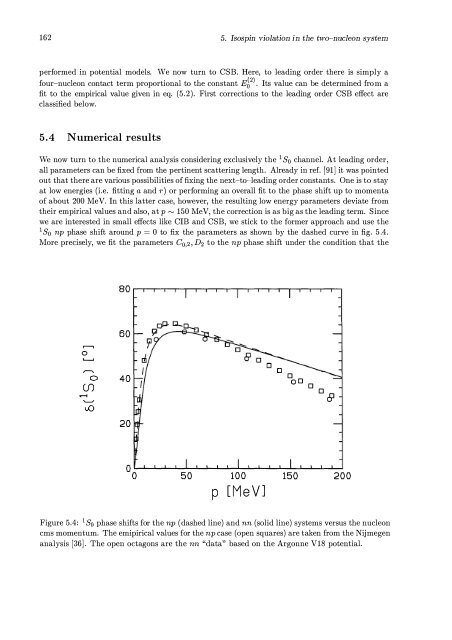The Nucleon-Nucleon Interaction in a Chiral Effective Field Theory
The Nucleon-Nucleon Interaction in a Chiral Effective Field Theory
The Nucleon-Nucleon Interaction in a Chiral Effective Field Theory
You also want an ePaper? Increase the reach of your titles
YUMPU automatically turns print PDFs into web optimized ePapers that Google loves.
162 5. Isosp<strong>in</strong> violation <strong>in</strong> the two-nuc1eon system<br />
performed <strong>in</strong> potential models. We now turn to eSB. Here, to lead<strong>in</strong>g order there is simply a<br />
four-nucleon contact term proportional to the constant E�2). Its value can be determ<strong>in</strong>ed from a<br />
fit to the empirical value given <strong>in</strong> eq. (5.2). First corrections to the lead<strong>in</strong>g order eSB effect are<br />
classified below.<br />
5.4 N umerical results<br />
We now turn to the numerical analysis consider<strong>in</strong>g exclusively the 1 So channel. At lead<strong>in</strong>g order,<br />
all parameters can be fixed from the pert<strong>in</strong>ent scatter<strong>in</strong>g length. Already <strong>in</strong> ref. [91] it was po<strong>in</strong>ted<br />
out that there are various possibilities of fix<strong>in</strong>g the next-to-lead<strong>in</strong>g order constants. One is to stay<br />
at low energies (Le. fitt<strong>in</strong>g a and r) or perform<strong>in</strong>g an overall fit to the phase shift up to momenta<br />
of about 200 MeV. In this latter case, however, the result<strong>in</strong>g low energy parameters deviate from<br />
their empirical values and also, at p rv 150 MeV, the correction is as big as the lead<strong>in</strong>g term. S<strong>in</strong>ce<br />
we are <strong>in</strong>terested <strong>in</strong> small effects like eIB and eSB, we stick to the former approach and use the<br />
1 So np phase shift around p = 0 to fix the parameters as shown by the dashed curve <strong>in</strong> fig. 5.4.<br />
More precisely, we fit the parameters CO,2, D2 to the np phase shift under the condition that the<br />
r--"1<br />
0<br />
'---'<br />
60<br />
r--- 0<br />
0 40<br />
Cf)<br />
.-I<br />
'--"<br />
V:)<br />
20<br />
0<br />
0 0<br />
0<br />
oe<br />
o���������������������<br />
o 50 100 150 200<br />
P [Me VJ<br />
Figure 5.4: ISO phase shifts for the np (dashed l<strong>in</strong>e) and nn (solid l<strong>in</strong>e) systems versus the nucleon<br />
cms moment um. <strong>The</strong> emipirical values for the np case (open squares) are taken from the Nijmegen<br />
analysis [36]. <strong>The</strong> open octagons are the nn "data" based on the Argonne V18 potential.












